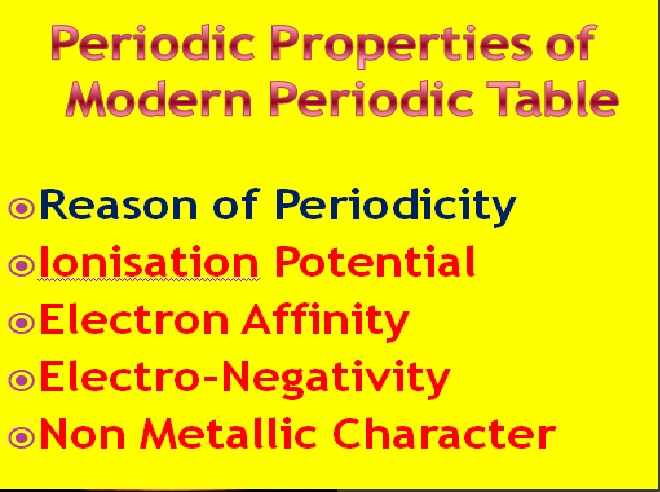Periodic Properties of Modern Periodic Table Class 10 ICSE Chemistry. The first chapter of ICSE Class 10 Chemistry is Periodic Table. In this article you would get notes and important point on Periodic Properties in Long Form of PT. Visit official website CISCE for detail information about ICSE Board Class-10 Chemistry.

Periodic Properties of Modern Periodic Table Class 10 ICSE Chemistry
Point to be Discuss
Reason of Periodicity
Atomic Radius
Ionisation Potential
Electron Affinity
Electro-Negativity
Non Metallic Character
Metallic Character
Reason of Periodicity
The primary cause of periodicity in the periodic table is the recurring patterns of valence electron configurations as you move across the periodic table. This means that elements within the same group (vertical column) tend to have similar properties because they have similar outer electron shells
Metallic Property
The metallic property of an element refers to its ability to conduct electricity.
The metallic properties increase as the nuclear charge decreases in the group. Because the valence electrons are loosely bound by the nucleus, they can conduct electricity well. The metallic property, on the other hand, decreases over time as nuclear charge accumulates.
Atomic Radii
the atomic radius is the distance between its nucleus and its outermost stable electron orbital.
The atomic radius shrinks as the nuclear charge increases. Because the force of attraction between the nucleus and the valence electrons increases as nuclear charge increases, the nucleus tightens its hold on the electron, resulting in smaller atomic radii.
Electro-negativity
Electronegativity is the ability of an atom or molecule to attract a pair of electrons.
With increasing nuclear charge, electronegativity rises. As you progress down a group, the electronegativity decreases as the nuclear charge decreases. The reason for this is that the distance between the nucleus of the atom and the valence electrons is large, making electron loss easy.
Electron Affinity
Electron affinity is the tendency of an atom to accept an electron or an electron pair. This is a hallmark attribute of nonmetals because they gain electrons and generate anions. As nuclear charge grows, the electron affinity rises with it. The group’s nuclear charge lowers as the nuclear charge decreases. Because fluorine has the highest electronegativity, noble gases are excluded. Because they have a full valence shell, they cannot gain or lose electron
Ionisation Energy
“Minimum energy required by an isolated atom to remove one electron in its neutral or gaseous state”
As one continues through the period, the ionisation energy increases. The reason for this is that as the nuclear charge increases over time, the nucleus tightens its grip on the electrons. The ionisation energy, on the other hand, decreases as one advances down the group. This is because as the nuclear charge decreases, the valence electrons move away from the nucleus. A number of things influence ionisation energy.
— : End of Periodic Properties of Modern Periodic Table Class 10 Notes Chemistry :–
- Concise Selina Chemistry Solutions for ICSE Class-10.
- Simplified Dr. Dalal Chemistry Solutions for ICSE Class-10
- Goyal Brothers Prakashan for ICSE Class-10 Chemistry Textbook
Thanks
Please Share with Your Friends


